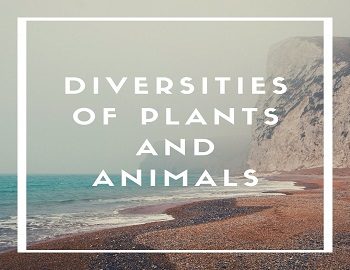Diversities Of Plants And Animals:
This world has innumerable kinds of living organisms- plants and animals. There is so much diversity of plants and animals that on superficial examination they are not believed to have anything common. This diversity includes tiny bacteria, other unicellular plants and unicellular protozoa (not visible to the naked eye) on one hand and the Banyan tree, camel, elephant and man himself (visible to the naked eye) on the other. In fact, the earth is populated with a very large number of plants and animals which show diversity in appearance, size, habitat and way of life.
The scientists have also discovered still smaller entity viruses. Viruses are microscopic particles often with geometrical shapes. These are midway between living and non-living things- living organisms within the cells and non-living chemicals outside the cells.
The physical nature of the habitats and climatic conditions play a major role in the diversity of living organisms. For example- the living forms of polar regions (polar bear, walrus, seal, penguin etc.) differ from the living forms of sandy deserts (thorny shrubs, camels, desert snakes, lizards etc.) or those of sea (weeds, jellyfish, whales etc.). India being a vast country has innumerable diverse forms of plants and animals. In spite of diversities, there exists a unique unity among all the living organisms. The fundamental material of all living organisms is protoplasm which in the living state includes a variety of organic molecules such as carbohydrates, fats, proteins, vitamins and other molecules.
Man has a unique place in the living world. He is the only animal who has studied the nature and has also tried to control his environment. By virtue of his learning capacity, he has always been on march to solve various problems concerning his health and future progress of the human race. The study of life sciences can help us to solve various problems such as radiation hazards, scarcity of food, diseases and over-population. In addition to these problems, the life scientists are trying to know about-
- The role played by genes in controlling the individual human characteristics.
- The cause and operation of life processes.
- The origin of life on earth.
| Major Group | Examples |
|---|---|
| Plants | |
| Thallophyta | Bacteria (Escherichia Coli, Diplococcus pneumoniae), Algae (Spirogyra, Ulothrix), Fungi (Mushrooms, Yeast). |
| Bryophyta | Liverworts, Mosses |
| Pteridophyta | Different forms of ferns |
| Spermatophyta or seed plants | Gymnosperms (Pine, Cedar, Cypress), Angiosperms (Wheat, Maize, Lotus, Rose, Mango, Neem). |
| Animals | |
| Protozoa | Amoeba, Euglena, Paramecium |
| Porifera | Sponges |
| Coelenterata | Hydra, Sea anemone, Jellyfish |
| Platyhelminthes | Liver-fluke, Tapeworm |
| Nemathelminthes | Hookworm, Pinworm, Guinea worm |
| Annelida | Earthworm, Leech, Sandworm |
| Arthropoda | Scorpions, Butterfly, Moth, Honey bee, Cockroach, Housefly |
| Mollusca | Slug, Snail, Mussel |
| Echinodermata | Starfish, Brittle star |
| Fishes | India shark, Labeo Rohita, Catla catla, Cirrhinus mrigala |
| Amphibia | Frogs, Toads |
| Reptiles | Snakes, Lizards, Tortoise |
| Birds | Peacock, Sparrow, Crow, Parrot |
| Mammals | Lion, Elephant, Cow, Monkey, Goat |
- Asexual Reproduction- Types, Characteristics And Significance
- Vegetative Propagation: Natural & Artificial Methods
- Parthenogenesis: Types And Significance
- Pollination: Types and Its Importance
- Chlorophyta- Green Algae
- Rhodophyta- Red Algae
- Bryophytes- Characteristics And Economic Importance
- Essential and Non-essential Parts of the Flowers
- Plant Growth and Development









Comments (No)